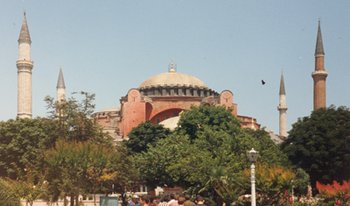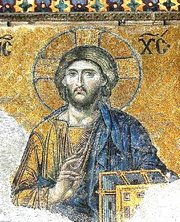Hagia Sophia
|
|
The Church of the Holy Wisdom, variously known as Hagia Sophia (Άγια Σοφία) in Greek, Sancta Sophia in Latin or Ayasofya in Turkish, is a former Greek Orthodox church converted to a mosque, now a museum, in Istanbul, formerly Constantinople. It is universally acknowledged as one of the great buildings of the world.
| Contents |
Construction
Nothing remains of the first church that was built on the same site during the 4th century. Following the destruction of the first church, a second was built by Constantius, the son of Constantine the Great, but was burned down during the Nika riots of 532. The building was rebuilt under the personal supervision of emperor Justinian I and rededicated on December 26, 536.
For architects Justinian chose Isidore of Miletus and Anthemius of Tralles, professors of geometry at the University of Constantinople; Anthemius, however, died within the first year. The construction is described in Procopius' On Buildings (De Aedificiis). The Byzantine poet Paulus the Silentiary composed an extant poetic ekphrasis, probably for the rededication of 563, which followed the collapse of the main dome.
Hagia Sophia is one of the greatest surviving examples of Byzantine architecture. Of great artistic value was its decorated interior with mosaics and marble pillars and coverings. The temple itself was so richly and artistically decorated that Justinian is said to have proclaimed "Solomon, I have surpassed thee!" (Νενίκηκά σε Σολομών).

Justinian's basilica was at once the culminating architectural achievement of late antiquity and the first masterpiece of Byzantine architecture. Its influence, both architecturally and liturgically, was widespread and enduring in the Eastern Orthodox, Roman Catholic, and Muslim worlds alike.
Description
Hagia Sophia is covered by a central dome with a diameter of 31 meters (102 feet), slightly smaller than the Pantheon's. The dome seems rendered weightless by the unbroken arcade of arched windows under it, which help flood the colorful interior with light. The dome is carried on pendentives-four concave triangular sections of masonry which solve the problem of setting the circular base of a dome on a rectangular base. At Hagia Sophia the weight of the dome passes through the pendentives to four massive piers at the corners. Between them the dome seems to float upon four great arches.
At the western (entrance) and eastern (liturgical) ends, the arched openings are extended by half domes carried on smaller semidomed exedras. Thus a hierarchy of dome-headed elements builds up to create a vast oblong interior crowned by the main dome, a sequence unexampled in antiquity.
The structure has been severely damaged several times by earthquakes. The dome collapsed after an earthquake in 558; its replacement fell in 563. There were additional partial collapses in 989 and 1346.
All interior surfaces are sheathed with polychrome marbles, green and white with purple porphyry and gold mosaics, encrusted upon the brick. On the exterior, simple stuccoed walls reveal the clarity of massed vaults and domes.
Later history
Hagia Sophia was the seat of the Orthodox patriarch of Constantinople and a principal setting for imperial ceremonies. During the Latin Occupation (1204-1261) the church became a Roman Catholic cathedral, and its many treasures and relics were dispersed. It was converted to a mosque at the Fall of Constantinople to the Ottoman Turks under Sultan Mehmed II in 1453. Since more conservative factions of Islam consider the depiction of the human form to be blasphemous, its mosaics were covered with plaster. (While figurative representation has never been completely banned in Islamic art, figures of humans in a mosque's decoration is generally forbidden.) For almost 500 years the principal mosque of Istanbul, Ayasofya served as model for many of the Ottoman mosques of Constantinople such as the Shehzade Mosque, the Suleiman Mosque, and the Rustem Pasha Mosque.
In 1934, under Turkish president, Hagia Sofia was secularized and turned into the Ayasofya Museum. Nevertheless, the mosaics remained largely plastered over, and the building was allowed to decay. A 1993 UNESCO mission to Turkey noted falling plaster, dirty marble facings, broken windows, decorative paintings damaged by moisture, and ill-maintained lead roofing. Cleaning, roofing and restoration have since been undertaken.
Although Turkey, and Istanbul in particular, are more secular than most Muslim countries, the status of Hagia Sophia remains a sensitive subject. The Islamic calligraphic displays suspended from the main dome remain in place. The Christian iconographic mosaics are being gradually uncovered.
See also
External links
- Contemporary description (http://gbgm-umc.org/umw/bible/procopius.stm) by Procopius, Buildings (De Aedificiis), published in 561 AD.
- Some 100 photos (http://www.pbase.com/dosseman/istanbul_aya_sofia) taken by Dick Osseman
- Introduction, with floor plan and elevations. (http://www.focusmm.com/civilization/hagia/welcome.htm)
- Very brief illustrated report on restorations (http://www.archaeology.org/online/news/sophia.html)
- Bibliographies (http://wiki.orientalische-kunstgeschichte.de/index.php/Konstantinopel%2C_Hagia_Sophia) to Hagia Sophia
- Painting by Turkish painter Ismail Acar: Before Hagia Sophia, The Era of East Roman Empire (http://www.ismailacar.com.tr/HsphiaHtml/006.htm), One of the most famous Christ mosaic of Hagia Sophia (http://www.ismailacar.com.tr/HsphiaHtml/009.htm), Hagia Sophia's horses, now in Venice Square (http://www.ismailacar.com.tr/HsphiaHtml/007.htm)
Reference
- Mainstone, Rowland J. (1997). Hagia Sophia: Architecture, Structure, and Liturgy of Justinian's Great Church (reprint edition). W W Norton & Co Inc. ISBN 0500279454.
- Hagia Sophia Church (http://www.islamicarchitecture.org/architecture/hagia.sophia.mosque.html) Also known as, Mosque of Holy Wisdom.



